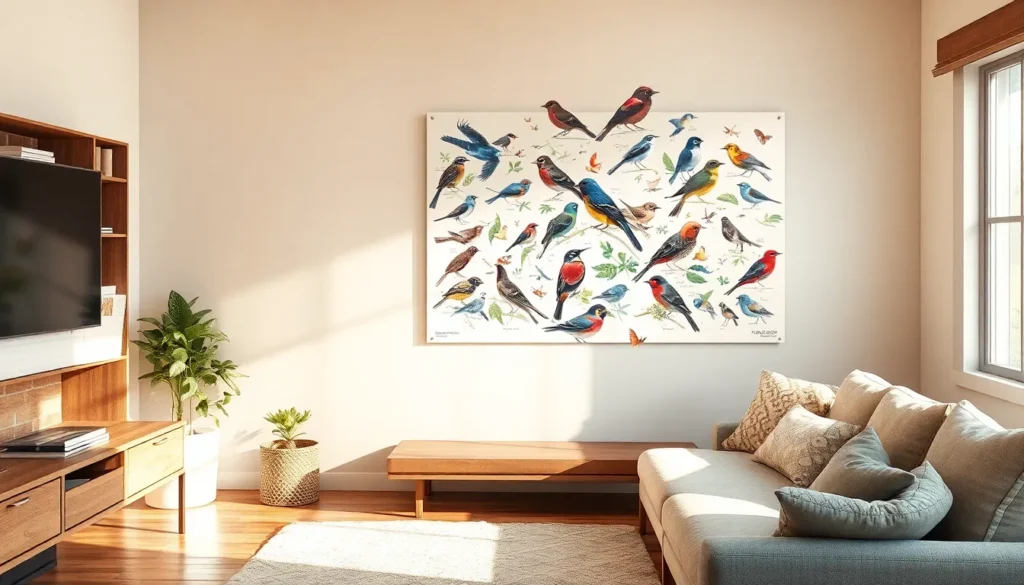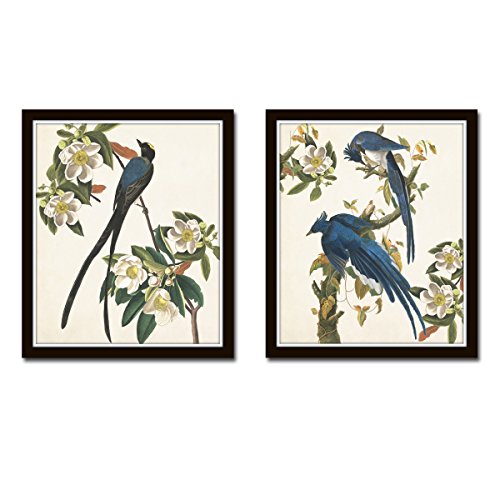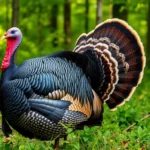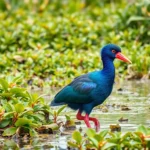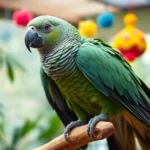We’ve all felt that instant connection when spotting a beautiful bird in nature – the vibrant flash of a cardinal’s red feathers or the graceful soar of an eagle against blue skies. Bird posters capture this magic and bring it into our homes, transforming any space into a nature lover’s sanctuary.
Whether you’re decorating a child’s bedroom, creating an inspiring office environment, or adding character to your living room, bird posters offer endless possibilities. From vintage Audubon illustrations to modern minimalist designs, these artistic pieces serve as both educational tools and stunning wall art that sparks conversation.
We’ll explore everything you need to know about choosing the perfect bird poster for your space, including popular styles, sizing considerations, and creative display ideas that’ll make your walls come alive with natural beauty.
Choose Educational Bird Identification Posters for Learning
Educational bird identification posters transform any learning space into an interactive ornithology classroom. We’ve found these specialized posters serve as invaluable teaching tools that combine visual appeal with scientific precision.
Scientific Accuracy and Species Detail
Scientific accuracy forms the foundation of effective bird identification posters for educational purposes. We recommend selecting posters that feature anatomically correct illustrations with precise color reproduction and accurate proportions. Field guides like those produced by Cornell Lab of Ornithology and National Geographic provide the gold standard for species representation.
Detailed species information enhances the learning experience significantly. Quality educational posters include common names alongside scientific nomenclature such as Turdus migratorius for American Robin. Wing span measurements, habitat preferences, and feeding behaviors add valuable context for students studying avian biology.
Regional specificity makes identification more relevant to local environments. We suggest choosing posters that focus on birds native to your geographic area rather than global collections. North American songbird posters work exceptionally well for classrooms in the United States and Canada.
Age-Appropriate Content and Layout
Age appropriate design elements ensure maximum educational impact across different learning levels. Elementary school posters benefit from larger illustrations with simplified text and bright colors that capture young attention spans. Middle school versions can include more detailed anatomical features and behavioral descriptions.
Font size and readability directly affect student engagement with the material. We recommend posters with clear sans serif fonts at least 12 points for body text and 18 points for species names. High contrast between text and background improves visibility from classroom distances.
Interactive elements encourage hands on learning experiences. Posters featuring QR codes linking to bird songs or migration patterns create multimedia learning opportunities. Some educational publishers now include augmented reality features that bring static images to life through smartphone apps.
Durable Materials for Classroom Use
Durable construction materials ensure long term classroom investment returns. We’ve found that laminated posters withstand daily handling by students while maintaining image clarity over multiple school years. Heavy duty paper stocks resist tearing and curling better than standard poster materials.
Fade resistant inks preserve color accuracy under fluorescent classroom lighting. UV resistant coatings protect against sun damage from windows while maintaining the vibrant colors essential for accurate species identification. Professional printing companies often guarantee color stability for educational materials.
Mounting options affect both durability and display flexibility. Posters with reinforced edges accommodate various hanging systems from push pins to magnetic strips. We recommend selecting posters compatible with standard classroom display hardware to ensure easy installation and repositioning throughout the academic year.
Select Vintage Bird Art Posters for Home Decor
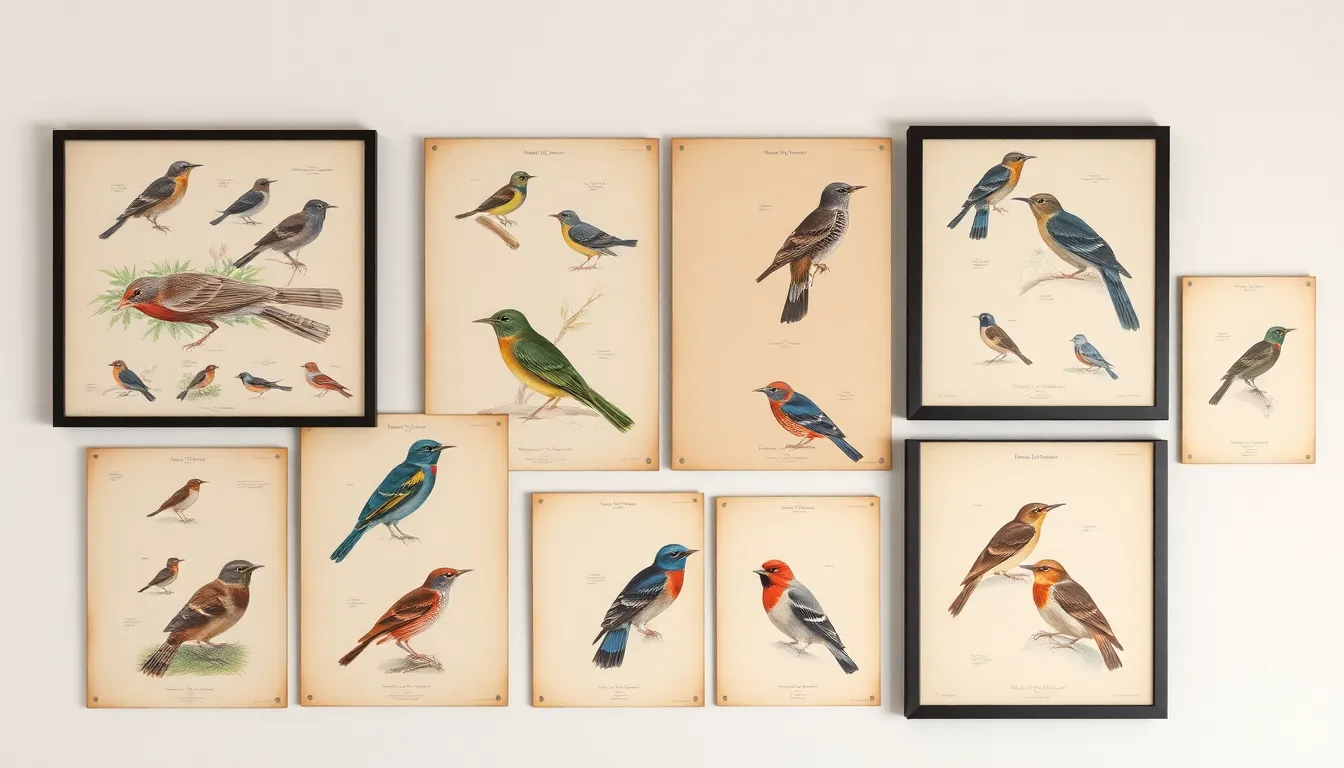
Vintage bird art posters capture the timeless elegance of ornithological illustration while adding sophisticated charm to any living space. These classic designs complement traditional and modern interiors with their refined aesthetic appeal.
Classic Audubon-Style Illustrations
Audubon style bird posters feature detailed watercolor illustrations that showcase birds in their natural poses and habitats. These reproductions draw inspiration from John James Audubon’s legendary “Birds of America” series, displaying species like cardinals, blue jays, and robins with scientific precision. We recommend selecting posters that maintain the original’s vibrant colors and intricate feather details to achieve authentic visual impact.
Premium Audubon reproductions often include handwritten script elements that mirror the naturalist’s original field notes. Museums and specialty art retailers offer high quality prints on archival paper that resist fading over decades. Popular species featured in these collections include the Great Blue Heron, Pileated Woodpecker, and Ruby Throated Hummingbird.
Antique Field Guide Reproductions
Field guide style posters present multiple bird species arranged in systematic grids or taxonomic groupings. These designs replicate vintage ornithology textbooks from the late 1800s and early 1900s, featuring species like warblers, finches, and sparrows with accompanying scientific names. We find these formats particularly effective in studies, libraries, and educational spaces where detailed reference information enhances the decor.
Authentic reproductions maintain original typography and scientific accuracy while adapting to modern poster dimensions. European field guides from renowned naturalists like Gould and Naumann offer distinctive illustration styles that differ from American counterparts. These posters typically showcase 12 to 24 species per print, creating comprehensive visual references that serve both decorative and educational purposes.
Sepia and Muted Color Palettes
Sepia toned bird posters create warm, nostalgic atmospheres that complement neutral interior color schemes. These monochromatic designs work exceptionally well in bedrooms, hallways, and reading nooks where subtle elegance takes precedence over bold statements. We suggest pairing sepia prints with cream, beige, or soft gray frames to enhance their vintage appeal.
Muted watercolor palettes featuring dusty blues, sage greens, and weathered yellows evoke antique botanical illustrations. These subdued color schemes coordinate beautifully with farmhouse, cottage, and transitional decor styles while maintaining visual interest through detailed linework. Distressed or aged paper textures add authenticity to reproductions, making them appear as genuine historical artifacts rather than modern prints.
Find Regional Bird Species Posters for Local Interest
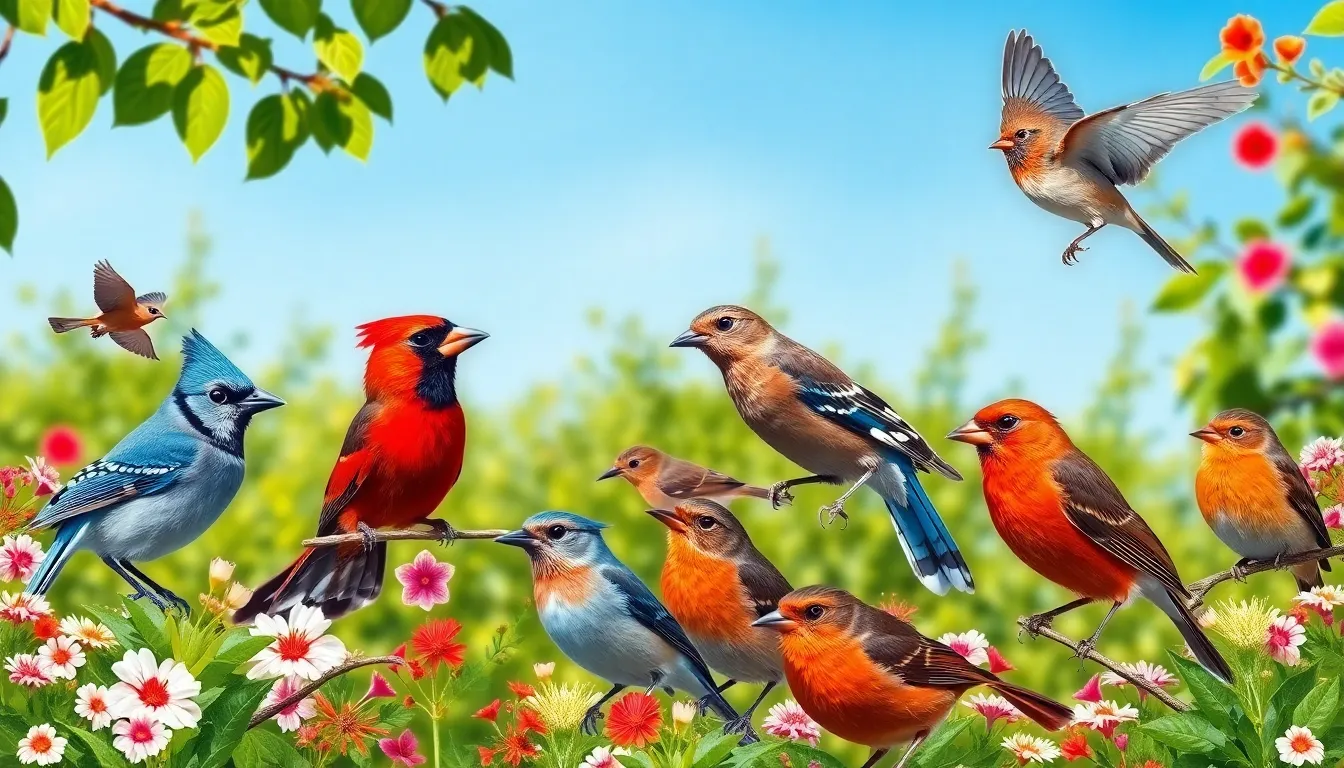
Connecting with your local network becomes more meaningful when you display birds that actually inhabit your area. Regional bird species posters transform any space into a window to your neighborhood’s natural community.
North American Backyard Birds
North American backyard bird posters showcase the most commonly observed species in residential areas across the continent. We find these collections typically feature 15-30 species including Northern Cardinals, Blue Jays, American Robins, House Finches, and Black-capped Chickadees. Popular publishers like Cornell Lab of Ornithology and National Geographic create scientifically accurate versions that include feeding habits and seasonal behaviors.
Regional variations make these posters particularly valuable for location-exact identification. Western collections highlight Scrub Jays and California Towhees while eastern versions emphasize Red-winged Blackbirds and Tufted Titmice. Size options range from compact 11×14 inches for small spaces to large 24×36 inches for educational displays.
Interactive features enhance the learning experience with many modern backyard bird posters. QR codes link to bird calls and migration patterns while seasonal indicators show when species are most active. Weather-resistant materials allow outdoor display in garden sheds or covered patios where bird watching naturally occurs.
Migratory Species Charts
Migratory species charts track seasonal bird movements through exact flyways and regions. We recommend posters that illustrate the four major North American flyways: Atlantic, Mississippi, Central, and Pacific routes. These educational tools typically display 20-40 species with arrival and departure dates for different latitude zones.
Seasonal timing information proves essential for planning bird watching activities and habitat management. Spring migration charts feature colorful warblers like Yellow, Magnolia, and Blackburnian species arriving between March and May. Fall migration displays show timing for shorebirds, raptors, and waterfowl moving south between August and November.
Geographic specificity makes migration charts valuable for local birding communities. Regional versions focus on species that regularly pass through particular states or provinces. Breeding range maps complement migration routes by showing where species nest versus where they simply pass through during seasonal movements.
Endangered and Protected Species
Endangered and protected species posters raise awareness about conservation needs while celebrating rare birds. We find these collections feature federally listed species like California Condors, Whooping Cranes, and Hawaiian Honeycreepers alongside their current population numbers and recovery status. Educational institutions particularly value these resources for environmental science curricula.
Conservation success stories provide hope and demonstrate effective protection efforts. Posters highlighting recovered species like Bald Eagles, Brown Pelicans, and Peregrine Falcons show population trends from near extinction to stable numbers. Recovery timelines and exact conservation actions illustrate how dedicated efforts save species from disappearing forever.
Habitat protection messages connect species survival to network preservation. Many endangered bird posters include habitat maps showing critical nesting areas, feeding grounds, and migration corridors that require protection. Supporting organizations like Audubon Society and local wildlife refuges becomes more meaningful when you understand which species depend on preserved landscapes.
Discover Specialized Bird Poster Categories
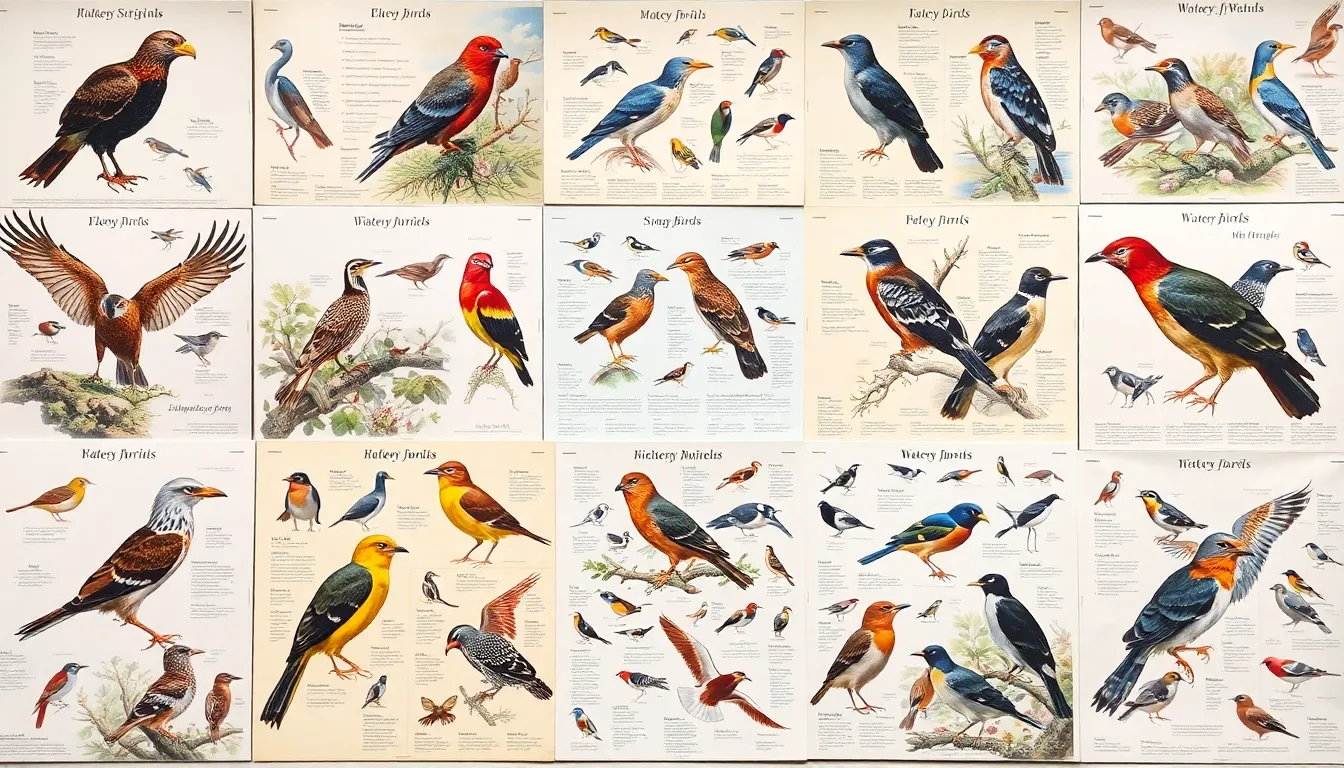
We’ll explore targeted bird poster collections that focus on exact avian groups, each offering unique benefits for enthusiasts and learners alike.
Birds of Prey Collections
Raptors command attention with their powerful presence and hunting prowess, making them ideal subjects for dramatic wall art. We recommend posters featuring North American raptors like red-tailed hawks, peregrine falcons, and bald eagles, which showcase intricate feather patterns and piercing gazes.
Flight silhouettes prove invaluable for birdwatchers learning to identify raptors from a distance. These specialized charts display wing shapes, tail configurations, and soaring patterns that distinguish different species during field observations.
Anatomy focused displays highlight the specialized hunting adaptations of birds of prey, including talon structures, beak variations, and eye positioning. Educational institutions particularly benefit from these detailed illustrations that explain predatory behaviors and ecological roles.
Habitat exact collections group raptors by their preferred environments, from forest dwelling goshawks to open grassland hawks. We’ve found these arrangements help viewers understand the relationship between bird behavior and network requirements.
Songbird Identification Charts
Backyard songbirds create the most popular category for residential bird posters, featuring species like cardinals, blue jays, and chickadees that frequent feeders and gardens. These collections typically include feeding preferences, nest locations, and seasonal behaviors.
Regional song charts incorporate QR codes linking to actual bird calls, transforming static posters into interactive learning tools. We recommend versions that feature common species alongside their distinctive vocalizations and territorial patterns.
Seasonal migration maps illustrate the movement patterns of songbirds throughout the year, showing breeding ranges, wintering grounds, and migration routes. These educational displays help viewers understand timing for optimal birdwatching opportunities.
Plumage variation guides showcase male and female differences, juvenile forms, and seasonal changes in songbird appearances. Advanced collections include molting patterns and age exact characteristics for serious bird identification study.
Waterfowl and Shorebird Guides
Wetland species posters feature ducks, geese, and swans in their aquatic habitats, emphasizing bill shapes and diving behaviors that distinguish different feeding strategies. We suggest collections that include both dabbling and diving duck categories.
Shorebird identification becomes significantly easier with specialized charts showing size comparisons, leg lengths, and bill curvatures. These posters typically arrange species by feeding zones, from shallow water sandpipers to deeper wading birds.
Flight formation displays illustrate the distinctive V patterns and flock behaviors of migrating waterfowl, including timing information for peak migration periods. Educational versions often include altitude preferences and navigation methods.
Breeding plumage charts capture the dramatic seasonal transformations of waterfowl, particularly male ducks during mating season. We recommend high resolution prints that showcase the iridescent colors and intricate patterns that make waterfowl identification both challenging and rewarding.
Consider Size and Placement Options for Bird Posters
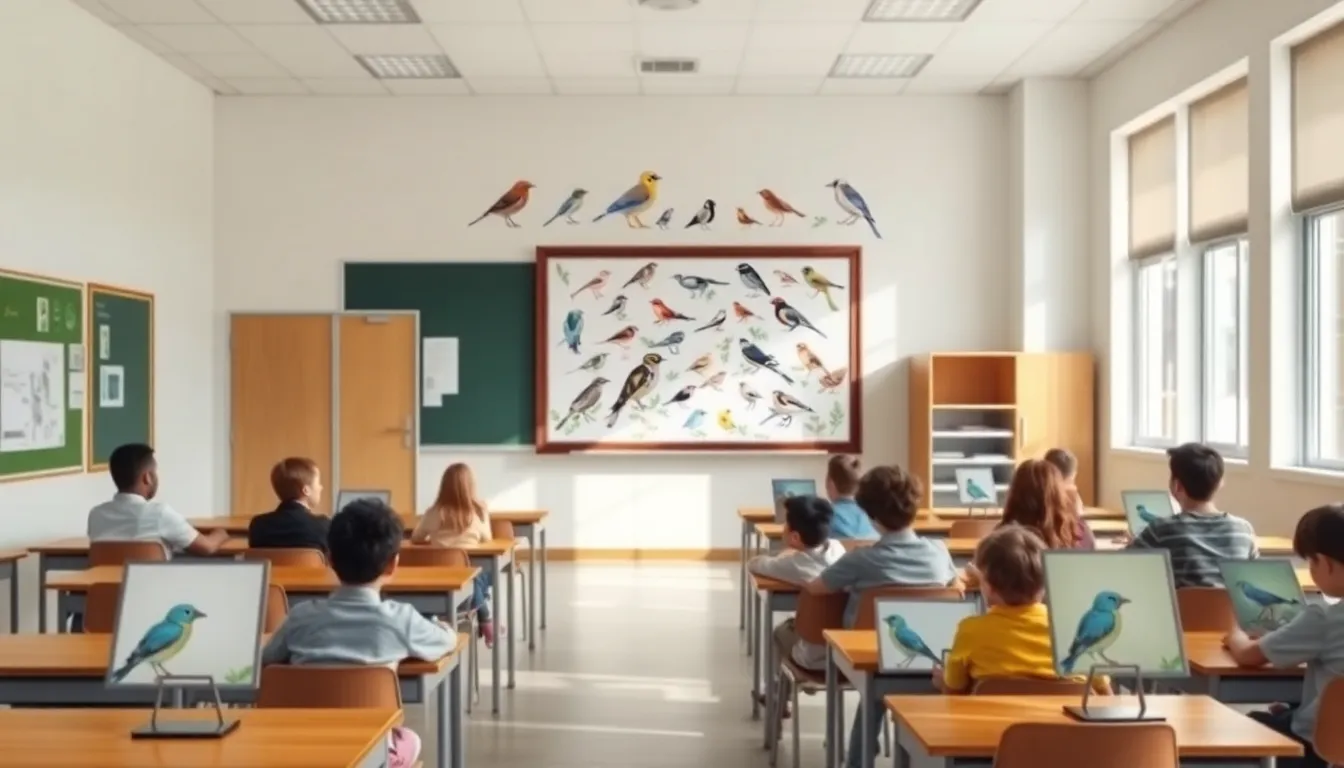
Selecting the right dimensions and positioning transforms your bird poster from a simple decoration into an impactful focal point. We’ll explore various sizing options and placement strategies to maximize visual impact and functionality in any space.
Large Format Wall Charts
Large format bird posters measuring 24×36 inches or bigger create stunning statement pieces that dominate wall space with impressive visual impact. We recommend these oversized charts for classrooms, nature centers, and spacious living areas where detailed species information needs to be visible from multiple viewing distances.
Educational institutions benefit most from jumbo-sized charts because students can easily read text and identify features from across the room. Museums, visitor centers, and outdoor education facilities often choose 36×48 inch formats that accommodate groups of viewers simultaneously.
Wall mounting requires sturdy hardware since large posters can weigh several pounds when properly framed. We suggest using wall anchors rated for at least 20 pounds to ensure secure installation on drywall surfaces.
Viewing distance becomes critical with large formats because optimal readability occurs when viewers stand 4-6 feet away from the poster. Conference rooms, waiting areas, and library spaces provide ideal environments where people naturally maintain appropriate distances for comfortable viewing.
Compact Reference Guides
Compact bird posters measuring 11×17 inches or smaller serve as convenient reference tools that fit comfortably in tight spaces without overwhelming room decor. We find these pocket-sized guides perfect for home offices, small classrooms, and personal study areas where quick species identification is the primary goal.
Desktop display stands accommodate compact posters beautifully, allowing easy repositioning during bird identification activities or seasonal learning sessions. Tabletop easels made from wood or metal provide stable support while maintaining portability for outdoor field experiences.
Laminated compact guides withstand frequent handling much better than paper versions, making them ideal for interactive learning environments. Children’s bedrooms and playrooms benefit from smaller formats because kids can safely examine details up close without damaging larger installations.
Travel enthusiasts appreciate compact guides that fold or roll for easy transport to birding locations, nature walks, and camping adventures. We recommend waterproof versions for outdoor use since weather conditions can quickly damage unprotected paper materials.
Framed vs. Unframed Options
Framed bird posters offer superior protection against dust, moisture, and accidental damage while adding professional presentation quality that enhances any interior design scheme. We suggest custom framing for vintage reproductions and high-quality art prints that deserve museum-level preservation and display treatment.
Glass or acrylic glazing prevents fading from UV light exposure, significantly extending the lifespan of colorful bird illustrations and photographic images. Non-glare options reduce reflections that can obscure details when posters are positioned near windows or bright lighting fixtures.
Unframed posters provide budget-friendly alternatives that work well in temporary displays, rental properties, and frequently changing educational environments. Magnetic strips, pushpins, and removable adhesive tabs allow easy installation without creating permanent wall damage or requiring special tools.
Matting options create visual breathing space around bird imagery while adding sophisticated color coordination that complements existing room palettes. We recommend neutral mat colors like cream, gray, or natural linen that won’t compete with the poster’s natural color schemes and species details.
Evaluate Print Quality and Paper Types
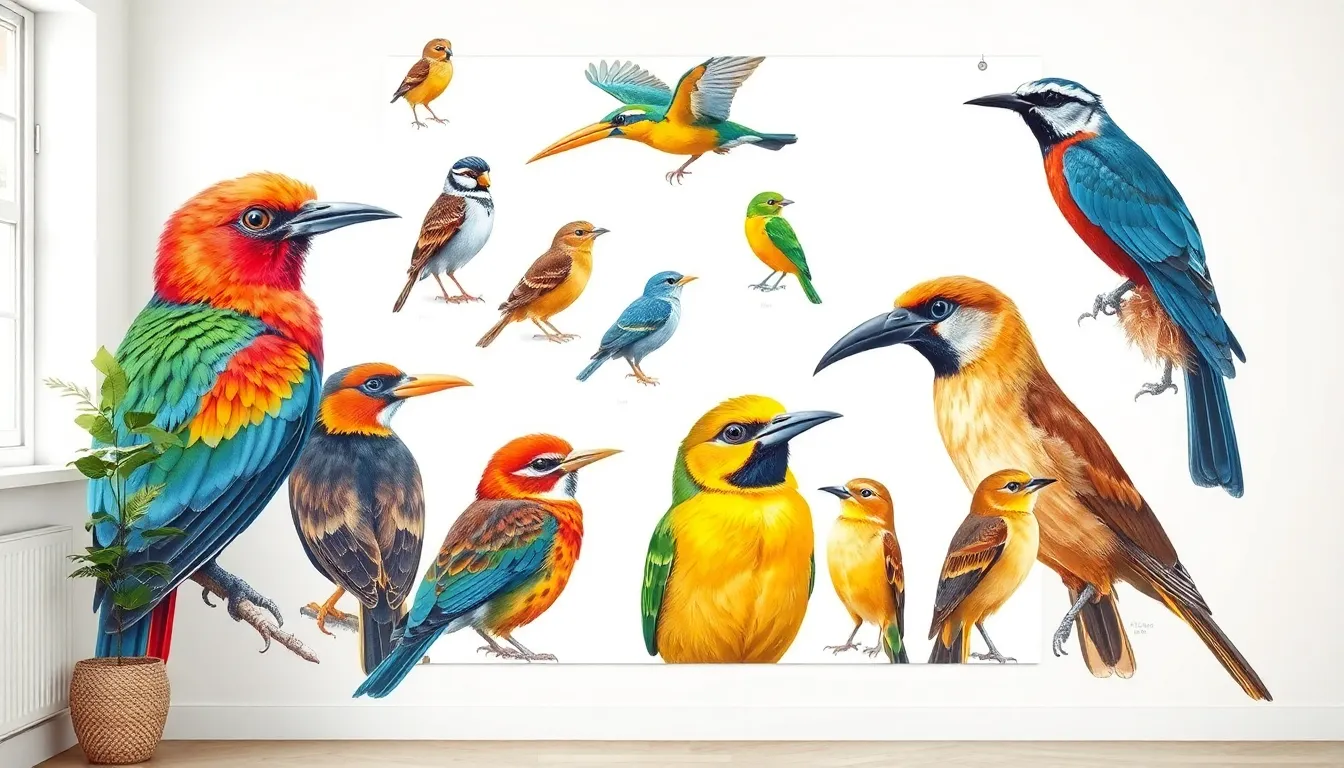
Selecting the right print quality and paper type ensures your bird poster maintains its vibrant colors and crisp details for years to come. We’ve researched the most durable and visually appealing options to help you make the best choice for your space.
High-Resolution Digital Prints
Professional bird posters require minimum 300 DPI resolution to capture the intricate details of feather patterns and beak structures. Modern digital printing technology produces sharp, clear images that rival traditional lithographic methods, especially when displaying complex species identification charts.
Inkjet printing systems deliver superior color accuracy for bird photography and watercolor illustrations. Canon and Epson professional printers excel at reproducing the subtle blues of jay feathers and the brilliant reds of cardinal plumage, maintaining color fidelity that matches the original artwork.
Large format printing capabilities extend beyond standard poster sizes without compromising image quality. We can find bird posters printed up to 44 inches wide while preserving crisp details in every wing feather and eye marking, perfect for classroom displays or statement wall pieces.
Color calibration ensures consistent reproduction across different printing batches and locations. Professional print shops use standardized color profiles to match Pantone colors, guaranteeing that your ruby throated hummingbird poster displays the exact emerald green found in nature.
Archival Quality Materials
Museum grade paper contains zero acid content to prevent yellowing and deterioration over decades. Cotton fiber papers like Hahnemühle and Canson maintain their original white brightness, ensuring your vintage Audubon reproductions retain their authentic appearance for generations.
Pigment based inks resist fading better than dye based alternatives when exposed to natural light. Professional bird poster manufacturers use Canon Lucia Pro or Epson UltraChrome inks, which maintain color stability for 100+ years under proper display conditions.
Heavyweight paper stocks between 200-300 GSM provide durability without excessive stiffness that causes cracking. Premium bird art prints use papers thick enough to prevent show through while remaining flexible enough for safe handling during installation.
Conservation framing materials extend poster lifespan significantly by creating protective barriers against environmental damage. Acid free matting and UV filtering glass shield your bird identification posters from harmful light exposure and atmospheric pollutants that cause premature aging.
Laminated Weather-Resistant Options
Outdoor bird poster displays require specialized weatherproof materials to withstand rain, snow, and UV radiation. Marine grade lamination creates waterproof barriers that protect bird identification charts used in nature centers and outdoor educational trails.
Classroom environments benefit from wipeable laminated surfaces that resist marker stains and frequent handling by students. Educational bird posters with protective lamination maintain their appearance even though daily use, sticky fingers, and occasional cleaning with mild detergents.
UV resistant coating prevents sun damage in bright classrooms and south facing windows. Quality lamination includes UV inhibitors that block up to 99% of harmful rays, preserving the vibrant colors of tropical bird species and preventing fading over multiple school years.
Tear resistant construction handles frequent transportation between classrooms and outdoor learning environments. Reinforced edges and flexible plastic coatings allow bird reference posters to bend without cracking, making them ideal for field trips and nature walks where portability matters most.
Compare Popular Bird Poster Brands and Publishers
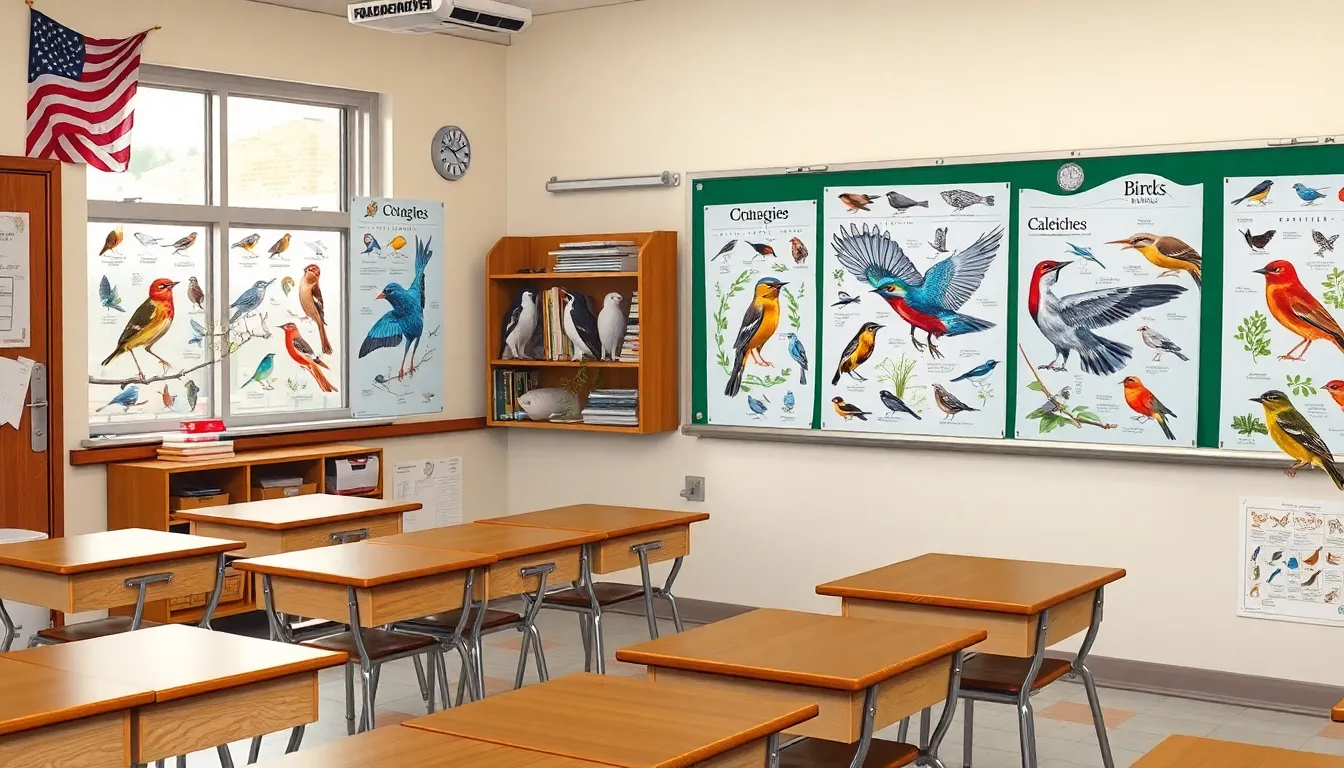
We’ve researched the leading bird poster publishers to help you choose quality products that deliver accurate information and stunning visuals. Each brand brings unique strengths to the bird poster market.
National Geographic Bird Guides
National Geographic transforms bird identification into visually spectacular experiences through their renowned photography and detailed illustrations. Their bird posters feature award winning wildlife photography that captures birds in natural behaviors and habitats.
Educational accuracy defines every National Geographic bird poster with scientifically verified species information and range maps. We recommend their North American Birds poster series, which includes over 200 species with precise identification details and habitat information.
Premium paper quality ensures longevity in National Geographic publications, using fade resistant inks and heavy weight paper stock. Their posters typically measure 24×36 inches and cost between $15 to $25, making them accessible for classrooms and home use.
Interactive elements enhance learning experiences through QR codes that link to bird calls and additional species information. Many National Geographic bird posters include migration patterns and seasonal behavior charts that support birdwatching activities.
Cornell Lab of Ornithology Materials
Scientific authority drives Cornell Lab’s bird poster collections as the leading ornithological research institution produces materials used by professionals and educators worldwide. Their eBird project data informs species distribution maps and seasonal occurrence charts.
Regional specificity characterizes Cornell Lab posters with state exact bird guides and habitat focused collections. We particularly value their “Birds of Your Region” series, which features locally relevant species with detailed behavioral descriptions and nesting information.
Research based accuracy ensures reliable identification features through partnerships with field ornithologists and citizen science contributors. Cornell Lab posters include morphological details, size comparisons, and sexual dimorphism illustrations that support accurate species identification.
Educational integration supports classroom learning with teacher guides and lesson plan materials accompanying many poster series. Their bird posters range from $12 to $30 and include supplementary digital resources for extended learning experiences.
Independent Nature Artists
Artistic interpretation brings unique perspectives to bird illustration through independent creators who combine scientific accuracy with creative expression. These artists often specialize in exact regions or bird families, offering detailed knowledge and personal artistic styles.
Limited edition prints create collectible value as independent artists typically produce smaller quantities with numbered editions and artist signatures. We’ve found exceptional work from artists like David Sibley and Charley Harper, whose distinctive styles appeal to both art collectors and bird enthusiasts.
Customization options allow personalized selections through direct artist relationships and commission opportunities. Many independent artists offer state exact collections, backyard bird series, or custom illustrations featuring locally observed species.
Price ranges vary significantly from $20 for small prints to $200 for large format limited editions, depending on artist reputation and print specifications. Independent artists often use archival quality materials and offer both digital and traditional printing methods to ensure longevity and color accuracy.
Budget-Friendly Bird Poster Alternatives
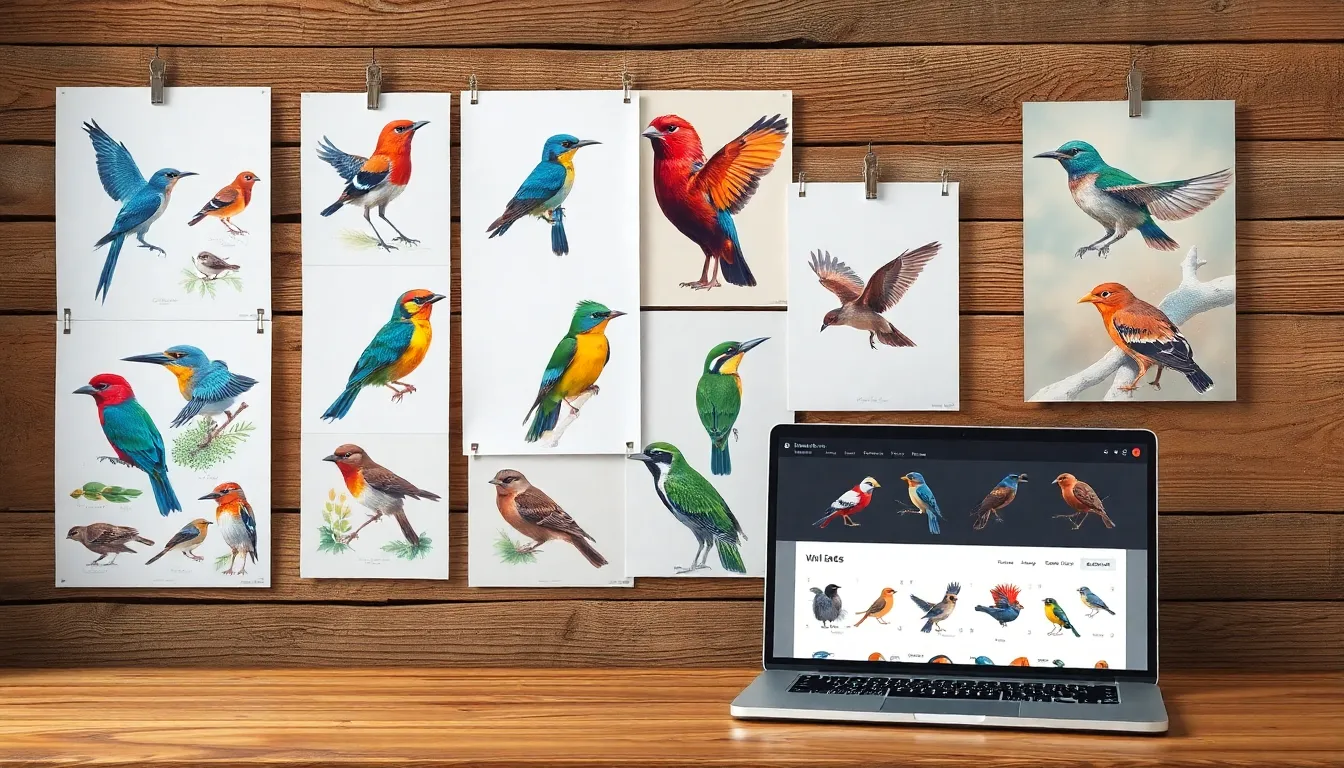
Creating beautiful bird displays doesn’t require very costly. We’ve discovered many cost-effective alternatives that deliver stunning results without compromising on quality or aesthetic appeal.
Downloadable Digital Prints
Digital bird poster downloads offer instant access to professional-quality artwork at fraction of traditional poster costs. We can purchase high-resolution files ranging from $3 to $15 and print them at local shops or home printers. Popular platforms like Etsy and independent artist websites feature thousands of bird illustration options, including vintage Audubon reproductions and modern minimalist designs.
Print quality reaches professional standards when we select 300 DPI files and use premium paper stocks. Many digital artists provide multiple size formats within single purchases, allowing us to create coordinated displays across different rooms. Educational downloads often include species information cards and identification guides as bonus materials.
Customization becomes effortless with digital formats since we can adjust sizing, cropping, and color saturation before printing. Several artists offer seasonal bird collections and regional species bundles that provide excellent value for creating themed displays.
Library and Museum Shop Options
Local libraries frequently maintain poster lending programs that allow us to borrow educational bird displays for extended periods. Museum shops offer deeply discounted prints from their permanent collections, especially during seasonal sales and membership events.
Educational institutions often surplus their teaching materials through public sales and online auctions. We’ve found classroom-quality bird identification charts for $5 to $20 that originally cost $50 or more. University bookstores occasionally clear inventory from biology and environmental science departments at important markdowns.
Natural history museums produce exclusive prints featuring their specimen collections and research findings. These poster alternatives provide scientific accuracy while supporting conservation education programs through our purchases.
DIY Bird Photography Collections
Creating personalized bird poster collections from our own photography provides unique displays that reflect local wildlife experiences. We can capture backyard visitors, migratory species, and regional specialties throughout different seasons to build comprehensive visual libraries.
Photo editing software transforms smartphone images into poster-worthy prints through cropping, color enhancement, and text overlay features. Free applications like GIMP and Canva offer templates specifically designed for educational and decorative bird displays.
Local printing services produce custom collections at reasonable rates when we batch multiple images together. We recommend creating themed series like “Backyard Birds of [Location]” or “Seasonal Migrants” that showcase our area’s avian diversity while providing educational value for family members and guests.
Conclusion
Bird posters offer us an incredible opportunity to transform any space into a celebration of avian beauty and knowledge. Whether we’re seeking educational materials for classrooms or decorative pieces for our homes we’ve discovered countless options to suit every need and budget.
From vintage Audubon reproductions to modern digital downloads we can find the perfect bird poster that matches our style and purpose. The key lies in choosing quality materials and accurate representations that’ll stand the test of time while inspiring appreciation for our feathered friends.
We encourage you to explore the diverse industry of bird posters and discover how these beautiful displays can enrich your environment while fostering a deeper connection with nature’s most captivating creatures.
Frequently Asked Questions
What types of spaces work best for bird posters?
Bird posters are incredibly versatile and work well in children’s bedrooms, offices, living rooms, and educational environments. They can transform any space into an engaging nature-focused area. Consider the room’s purpose when selecting styles – vintage illustrations for sophisticated living spaces, educational charts for classrooms, and colorful species guides for children’s rooms.
How do I choose the right size bird poster for my space?
Large format wall charts (24″x36″ or bigger) work best for classrooms and spacious areas where visibility is key. Compact reference guides suit smaller spaces like home offices or study areas. Consider the viewing distance and available wall space when selecting dimensions to ensure your poster becomes an effective focal point.
What makes educational bird identification posters effective for learning?
Effective educational bird posters feature scientifically accurate illustrations, clear species information, and age-appropriate design elements. Look for anatomically correct depictions, readable fonts, and interactive features like QR codes. Posters showcasing local species relevant to your region enhance practical learning and field identification skills.
Are vintage bird art posters suitable for modern home decor?
Yes, vintage bird art posters add timeless elegance to modern spaces. Classic Audubon-style illustrations and sepia-toned prints create sophisticated focal points. These posters pair well with various decor styles, from traditional to contemporary, and their muted color palettes often complement existing color schemes while adding natural charm.
What’s the difference between framed and unframed bird posters?
Framed posters offer protection from damage, UV rays, and moisture while providing a polished, professional appearance. Unframed options are budget-friendly and ideal for temporary displays or frequent rotation. Framing extends poster longevity significantly, making it worthwhile for permanent installations or high-quality prints you want to preserve.
How important is print quality for bird posters?
Print quality is crucial for accurate color representation and detail clarity, especially for educational purposes. High-resolution digital prints with archival quality materials ensure vibrant colors and crisp details. Professional printing technologies and pigment-based inks provide superior durability and fade resistance compared to standard home printing methods.
Which bird poster brands offer the best quality and accuracy?
National Geographic and Cornell Lab of Ornithology are top choices for scientifically accurate, high-quality bird posters. National Geographic offers award-winning photography, while Cornell provides research-based educational materials. Independent nature artists also create unique, collectible pieces with artistic interpretations that combine beauty with accuracy.
Are there affordable alternatives to expensive bird posters?
Yes, downloadable digital prints offer professional-quality artwork at fraction of traditional poster prices. Etsy and similar platforms provide diverse options. Local libraries and museum shops often sell affordable educational displays. Creating DIY bird photography collections using your own photos is another cost-effective way to personalize your space.
What paper types work best for different bird poster applications?
Museum-grade paper with pigment-based inks offers the best longevity and color accuracy for permanent displays. Laminated options provide weather resistance for outdoor use or high-traffic classroom environments. Standard photo paper works well for temporary displays or budget-conscious buyers, though it may fade faster than archival materials.
How do regional bird species posters enhance local wildlife awareness?
Regional bird posters connect viewers to their local avian communities by featuring species commonly found in specific areas. They’re practical for backyard birdwatching, include relevant migration patterns, and often highlight conservation efforts for local endangered species. This targeted approach makes bird identification more relevant and achievable for observers.

